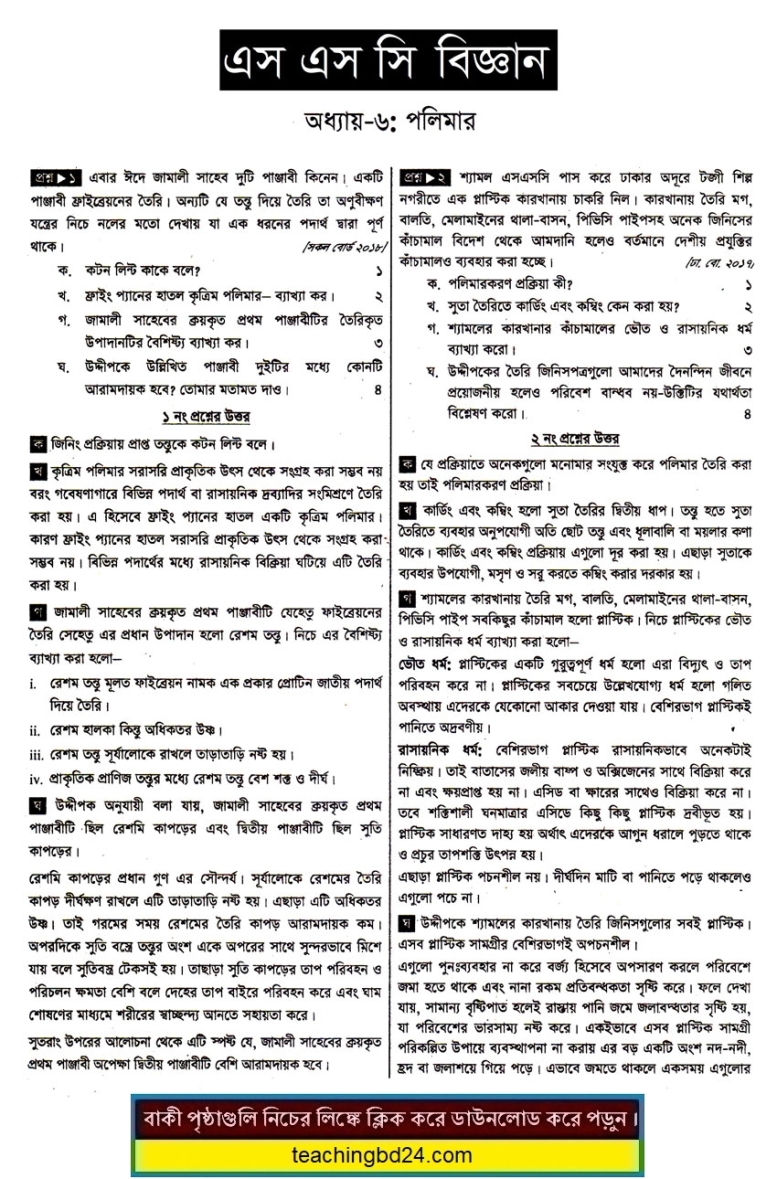Chapter 6. Polymer
Chapter 6. Polymer. Introduction: In our daily life different types of polymer substances are closely related. Some of them are natural while others are synthetic. Some of the polymer substances are environment-friendly and some of them are harmful to the environment.
Household items of melamine, electric switchboard, carpets, PVC pipes, polythene bags, jute bags, silk, wool, cotton, nylon, rubber, all these items are very useful and well known to us. All of them are polymers. The word “polymer” came from two Greek words “poly” which means many and “meros” which means part. So, if many small parts are linked together to form a large object, it can be termed a polymer. Consider the structure of an iron chain where small pieces of iron are connected to make the chain. So the chain here can be considered as a polymer. In chemistry, a polymer is formed by the chemical linking of monomer molecules.
Chapter 6. Polymer


A polymer is a chemical compound with molecules bonded together in long repeating chains. Because of their structure, polymers have unique properties that can be tailored for different uses. Polymers are both man-made and naturally occurring.
Polymers are studied in the fields of biophysics and macromolecular science, and polymer science (which includes polymer chemistry and polymer physics). Historically, products arising from the linkage of repeating units by covalent chemical bonds have been the primary focus of polymer science; emerging important areas of the science now focus on non-covalent links.
Polyisoprene of latex rubber is an example of a natural/biological polymer, and the polystyrene of styrofoam is an example of a synthetic polymer. In biological contexts, essentially all biological macromolecules—i.e., proteins (polyamides), nucleic acids (polynucleotides), and polysaccharides—are purely polymeric, or are composed in large part of polymeric components—e.g., isoprenylated/lipid-modified glycoproteins, where small lipidic molecules and oligosaccharide modifications occur on the polyamide backbone of the protein.
Polymerization is the process of combining many small molecules known as monomers into a covalently bonded chain or network. During the polymerization process, some chemical groups may be lost from each monomer. This happens in the polymerization of PET polyester. The monomers are terephthalic acid (HOOC—C6H4—COOH) and ethylene glycol (HO—CH2—CH2—OH) but the repeating unit is —OC—C6H4—COO—CH2—CH2—O—, which corresponds to the combination of the two monomers with the loss of two water molecules. The distinct piece of each monomer that is incorporated into the polymer is known as a repeat unit or monomer residue.
Laboratory synthetic methods are generally divided into two categories, step-growth polymerization, and chain-growth polymerization. The essential difference between the two is that in chain-growth polymerization, monomers are added to the chain one at a time only, such as in polyethylene, whereas in step-growth polymerization chains of monomers may combine with one another directly, such as in polyester. Newer methods, such as plasma polymerization do not fit neatly into either category. Synthetic polymerization reactions may be carried out with or without a catalyst. Laboratory synthesis of biopolymers, especially of proteins, is an area of intensive research.
teachingbd24.com is such a website where you would get all kinds of necessary information regarding educational notes, suggestions and questions’ patterns of school, college, and madrasahs. Particularly you will get here special notes of physics that will be immensely useful to both students and teachers. The builder of the website is Mr. Md. Shah Jamal Who has been serving for 30 years as an Asst. Professor of BAF Shaheen College. He expects that this website will meet up all the needs of Bengali version learners /students. He has requested concerned both students and teachers to spread this website home and abroad.

